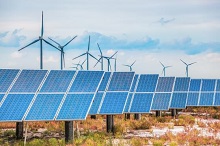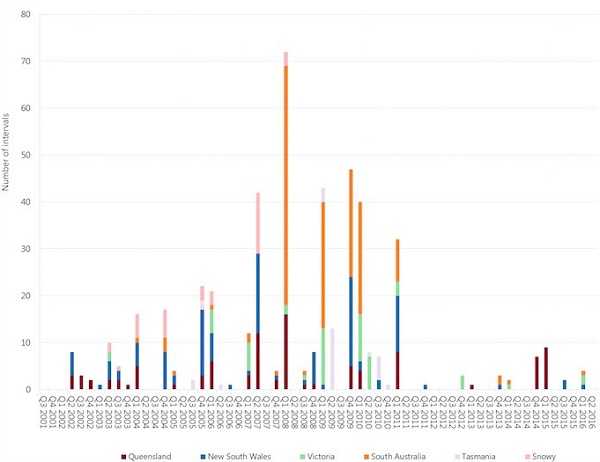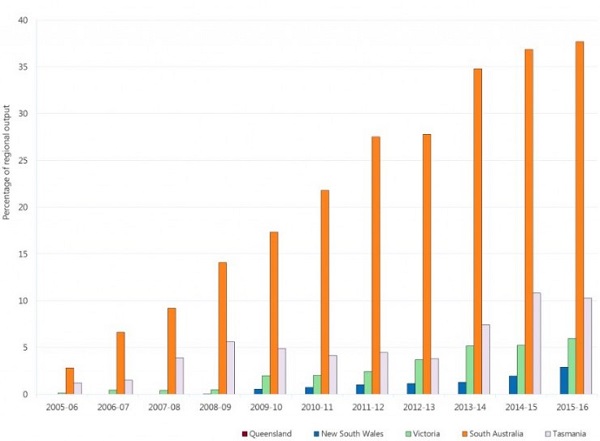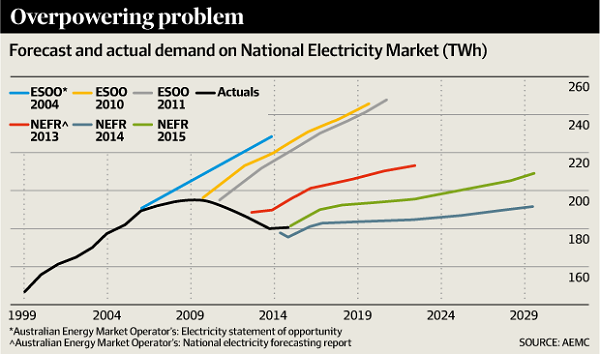 Continuity of electricity supply is no trivial matter. Back in April-May 1996 at our place we had rain on 14 consecutive days. Over the period we had 833 mm or over 33 inches in the old language. A renewable energy electricity supply system needs to survive such a challenge, as do home off-gridders. Imagine not just the lights out, but rotting food in the refrigerator, no pumping of petrol at the bowser, the refrigerators and lights failing at the supermarket, no water coming out the tap. For the whole Brisbane area.
Continuity of electricity supply is no trivial matter. Back in April-May 1996 at our place we had rain on 14 consecutive days. Over the period we had 833 mm or over 33 inches in the old language. A renewable energy electricity supply system needs to survive such a challenge, as do home off-gridders. Imagine not just the lights out, but rotting food in the refrigerator, no pumping of petrol at the bowser, the refrigerators and lights failing at the supermarket, no water coming out the tap. For the whole Brisbane area.
Now with interconnected grids through the National Electricity Market (NEM) established in 1998 South Australia withstood a lesser challenge recently albeit with a huge spike in electricity spot prices, arguably prompting a showdown on where we are going with renewable energy and fossil fuels in this country.
The man in the centre, Minister for the Environment and Energy, Josh Frydenberg, wants more gas, to meet peak demand and to supply baseload power, and wants an end to bans on coal seam gas development in NSW and Victoria.
If Frydenberg thinks we need gas baseload in general to replace coal, he’s wrong. The vanishing planet’s emissions budget means we have to go directly from coal to renewables.
The fossil fuel proponents, by definition climate deniers, really need SA’s experiment with wind and solar to fail. Objectively, as Giles Parkinson points out, it hasn’t. This graph shows how spikes (per quarter, spikes above $5,000/MWh) in prices have faded away in recent years:

Take out a couple of recent spikes in Queensland and they’ve faded right away. Inconveniently for fossil fuel proponents, this coincides with the advent of renewables. Parkinson says there is now about 5 GW of solar on rooftops, which has smoothed daytime peaks and pushed them later in the day.
In SA he says 7% of their electricity comes from solar and a whopping 37.7% from wind. Here is the growth in wind:

Queensland which now has the largest spikes has the lowest penetration of large-scale renewables.
Richard Dennis in an opinion piece published in the AFR said the anti-renewable complainers about the SA price hike were either hypocritical or ill-informed. That included quite a few LNP politicians.
Frydenberg seems to have the SA story roughly right, compared with what really happened, telling the Clean Energy Summit dinner that while short-term prices had jumped three times above the $5000 per megawatt-hour mark this year they did so more than 50 times in the first quarter of 2008.
That article also notes that there is mutual respect and communication between Frydenberg and Mark Butler, Labor’s climate change and energy spokesman, so we hope for better days.
It’s time to think of a way forward.
Frydenberg has called a meeting of the relevant state ministers for August 19.
One of the problems is that the focus in setting up the National Electricity Market in 1998, was on privatisation, competition, fragmentation and profit in an area which was perhaps a natural monopoly, benefitting by integration and co-ordination. One of the rules is that the system operator Australian Energy Market Operator (AEMO) has to maintain a reserve of 850 megawatts of reserve across the entire NEM. No account is taken of the carbon intensity of output, all that matters is price.
The SA event was seen as a challenge to system reliability, so the Australian Energy Market Commission, which sets the rules, announced on 12 July a review
- on whether wholesale energy market frameworks are suitable to complement increasing volumes of renewable energy and to maintain power system security as the industry transforms.
Should have been done years ago.
Some folks are fond of telling us that the energy suppliers who relied on price peaks for a quarter of their revenue will now have to change their business models. Such folks also tend to be enthusiastic about the possibility of going off-grid. However, there is not a lot of consideration of what the end shape of the system would look like.
To tackle the off-grid issue, I think standards should be set which people have to meet before disconnecting. In the end there will be a grid serving vital community facilities and households lacking the capital to go solo. Everyone has an interest. There will also be equity issues.
For starters, I think that anyone contemplating going off-grid should be able to outlast a 1 in 100 weather event that effects supply, which is possibly what the Brisbane 1996 experience was. If a back-up generator is part of the plan it should be carbon-free.
What is needed amounts to a home electricity generation plan.
Ergon Energy has developed a 10-point checklist of things to consider before going off-grid. It’s quite demanding, and for example asks what you are going to do when the system breaks down and you are waiting for parts from overseas.
The grid itself needs to be smarter and more robust. Ours is the world’s longest interconnected power system, more than 5000 kilometres from Port Douglas in Queensland to Port Lincoln in SA. It needs the main centres better connected.
A possible model is Spain, where Red Eléctrica de España, a single part publicly-owned company, operates the national electricity grid. Mark Mulligan reports. In Spain:
- sun and wind together account for about 25 per cent of generation capacity, ahead of natural gas at 17 per cent, coal at 16 per cent and hydro-electric production at 14 per cent.
Along the way they’ve developed a cluster of renewable energy companies with world-wide clout.
- The country’s grid management, too, is considered among the most sophisticated in the world, featuring state-of-the-art control centres loaded with software that can accurately predict and manage the variability of renewable energy.
As part of this precision management, all electricity companies are required to inform Red Electrica, the national grid company, of their anticipated power output for the following day.
This is broken down into five-minute segments, and must be accurate to within 5 per cent of forecast output, with fines when companies undershoot.
In addition, Red Electrica might require power producers to ramp up production during a surge in demand during the day, or to switch off wind turbines if demand drops.
Producers get paid a premium for being able to adjust output at short notice.
In the same issue of the AFR, Ben Potter and Mark Ludlow put together a piece Energy: Get NEM design right first.
- The National Electricity Market of the future will be vastly different to the one that serves the eastern states today.
It will include more high-voltage interstate “interconnectors”, and more wind, solar and gas power. It will have more technology to manage the flow and wind and solar, less coal power, and it will have utility-scale batteries to better match supply and demand.
It will also depart from the “energy only” market model to include a “capacity market” – payments to fossil fuel generators to stand by to fill gaps in supply when wind and solar energy can’t meet demand.
Reducing carbon emissions needs to be a top-line objective alongside reliability, efficiency and affordability. The Government needs to set renewable energy targets further ahead than 2020, plus accept the need for an eventual zero carbon energy supply.
Read the article for the detail.
One of problems we have is the multiplicity of players, each trying to maximize financial gain, including state players. The 2016 SA problem arguably has its origin in 1998 when the Liberal government cancelled a plan for a connector to NSW in order to enhance the value of state power plants, scheduled for privatisation. It took the ACCC chief 30 years to work out that privatisation on natural monopoly public infrastructure damages the economy.
Achieving a modern integrated clean energy market won’t be cheap, but they say the smart money is heading in that direction. For example:
- This week the Liberman family-backed Impact Investment Group launched a $100 million fund to anchor $1 billion of solar investments, Queensland Investment Corp tipped $800 million into AGL Energy’s $2 billion-plus renewables fund, and NSW transmission giant Transgrid backed a plan for a $500 million South Australia-NSW interconnector to avert power crises in SA.
The plunging cost of big solar, and of battery storage, will help.
There is argument about the “capacity market” concept. Britain is heading in that direction. Ontario and Western Australia are already there, and it costs. John Pierce, the Australian Energy Market Commission chairman, doesn’t like the idea. He says it will need a Fat Controller who will be too conservative and want too much in reserve.
No doubt he knows, because this is what the Fat Controller forecast in the past, against what happened:

I wonder what the existing “850 megawatts of reserve” actually means in practice.
Either reserve capacity is necessary or it is not. I came to the conclusion in my recent post that it was.
Bruce Mountain, director of energy consultancy CME, consulted by Potter and Ludlow, says it may be unavoidable.

You might begin to appreciate the thinking behind my domestic package specification of combined PVET’s, battery backup and a 2.5 Kw natural gas (or propane in non street gas areas) fueled generator. This combination provides a seamless solution for solar and non solar periods.
I’ve just spent two days at the Sydney Boat Show where many of the elements of the future off grid dwelling are available off the shelf. Particularly interesting is the affordability of battery technology. I was quite encouraged.
I should point out that the advantages of a 2.5 Kw gas fueled domestic generator (very specifically the Liquid Piston rotary engine at 30% efficiency) are that the engine provides energy to charge batteries and another 40% (2.8Kw) in the form of heat energy to recharge hot water cylinders. This makes the use of the gas during the low solar periods equal to or better than the most efficient combined cycle grid generators 61.5% efficient. The other advantage in the medium to long term is that the investment cost of the over capacity in the system is borne by the consumer for whom it is a small part of their energy system investment.
So Josh Frydenberg is right in pointing to gas being an important part of the future, but most of that gas should be coming from our municipal waste.
Brian: A good article that highlights the complexity of our power supply system and indirectly highlights what happens when inappropriate privatizations are made and pricing is based on equally inappropriate marketing systems.
I would tend to agree with Bilb and Frydenberg that there is a short term role for gas but in the longer term… For example, in the case of SA, it makes a lot more sense to keep existing gas fired power stations on paid standby instead of wasting money on a new connector to NSW. In the longer term the gas fired capacity should be permanently shut down once enough solar tower capacity becomes part of the supply system. (Solar tower includes energy storage and back-up in the form of auxiliary heating
Building extra renewable capacity is not the total story. Acting to reduce energy needs, more sophisticated forms of controlled power and energy storage should also be part of the mix.
This is what happens when we try ridiculous financial incentives to change behavior. Smart meters in Vic cost consumers $2 billion for no benefits!
Hardly surprising since daily power costs are so low.
I’m pleased you brought that up, John D. You will be even more disparaged when you find out what really went on.
http://www.smh.com.au/business/smart-meters-but-at-whose-expense-20121223-2btjd.html
Add that to the grid gold plating story and you will see just how cynically Australians are duped by our ignorant politicians and incompetent bureaucrats.
https://www.themonthly.com.au/issue/2014/july/1404136800/jess-hill/power-corrupts
Loverly Bilb, the Governments efficiency with spending OPM in stunning detail. Thanks.
Our latest power consumption was 8.75 kWh per day. At the peak rate this would have been about $2/day.
Now tell me – at this rate who is going to hover over their smart meter trying to save a few cents?
The smart meter was an enormous con not helped by economists who think price signals are what it is all about and bullshit detector deprived pollies who are stupid enough to listen to economists.
Jumpy, this sad power saga completely demolishes any notion of the “efficiencies” of private (and privatised) enterprise.
Precisely, John D. Economists have a lot to answer for in the way they played the public straight into the hands of opportunistic backroom manipulators. When historians write this up in the future I believe this will be seen as Australia’s version of Yeltsin’s Oligarchs with Kevin Rudd taking the role of Yeltsin.
John, that metre thing sounds like a con job by a sales person seeing an opportunity. It’s what you get when there is no effective system planning.
BilB, I remember that Jess Hill article which appeared in 2014. At the time my young son was doing a project for Energex on electricity pricing as a mathematics honours project. He was on a scholarship funded by Energex, and did actually work for them as an employee for a time. As such he couldn’t say much, but he did say that at the time the peaks were still going up in Qld.
The article itself says that energy suppliers were charged with meeting a once in 10 years peak. With climate change that’s hard to cover when you are planning several years out.
The last image in the post shows the difficulty they had in planning demand. Planning for peaks would have been even harder.
I’m not saying there wasn’t profit-seeking opportunism, that’s beyond knowing for me, but I suspect there was a fair degree of technical difficulty in the decision-making as well.
BilB, I do appreciate your domestic power arrangements as outlined in the first comment.
Problem is that at the end of the day there is going to be a grid, and the more people who opt out the more expensive it’s going to be for those who are left, and some of these are not going to be able to pay.
At the end of this article by Sophie Vorrath and Giles Parkinson they are basically recommending that a small business go off-grid with solar and batteries backed by diesel.
I think that’s irresponsible without considering the implications for the whole system, and the environmental implications of proliferating diesel.
I’d rather see a system where everyone is connected, where people who generate excess power are able to sell into and draw from the grid. My instinct is that that would be best environmentally and socially.
I’d like to see mathematical modelling that looks at decentralised production, but in terms of what’s best for the environment, while fair, reasonable and economically viable.
Out of that should come a system with rules, and perhaps incentives and penalties.
There’s another whole issue with gas prices that I don’t understand and didn’t have time to go into.
I understand that a significant part of what caused the crisis in SA was the closure of the Pelican Point gas-fired power plant. We’ve been told that the owners could make more money by selling the gas offshore.
But we were also told on TV tonight that people buying our gas offshore are getting their electricity cheaper than ours.
Last week we were told that the coal seam gas going through Gladstone is being given away, because the price is determined by the price of oil.
Yet the domestic price of gas has gone through the roof because of the export price.
I’m waiting for an article that opens the whole issue up.